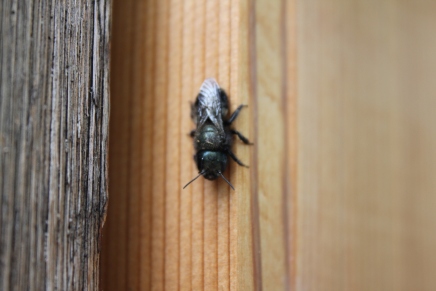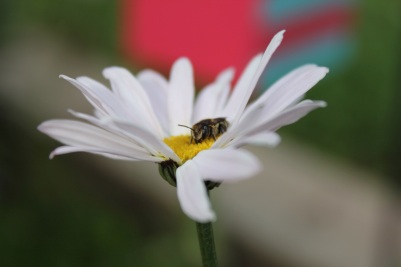Lives of Solitary Bees
Lives of Solitary Bees
by The Bees Waggle
Do solitary bees such as Mason Bees and Leafcutter Bees live through the winter? Well, to put it simply, no. The mason and leafcutter bees you have seen flying from flower to flower and back to their nesting holes will die off, and the egg cells they have built become the future army of solitary bees, and will emerge next spring and summer. Solitary bees live alone and lay eggs alone, so they do not have the resources that honey bees do to overwinter (more on that topic next week!). Solitary bees will happily nest next to another solitary bee, and never show aggression toward each other, no time for tomfoolery!

Here’s a review of what mason bees do!
Mason bees have only one purpose, to procreate, and this motivates them to pollinate with fierce efficiency!
Female mason bees emerge early spring, find a nesting site, and proceed to collect as much pollen and nectar as possible before they begin laying eggs. Mason bees do not have carrying baskets on their hind legs, but collect lots of pollen via static cling on their abdomens. They dive into flowers and immerse themselves in the center of flowers and cover their bodies with pollen before moving to the next flower. This makes them fairly inefficient at carrying pollen over long distances, but efficient at pollinating because they dive into flowers and transfer lots of pollen from flower to flower.
They work vigorously from early morning until early evening, and cover impressive pollinating ground in that time span. One mason bee can pollinate what 100 honey bees can in one day. Wow! But what’s the big rush? Why are these bees working so hard? Mason bees have a much shorter life span than honeybees, and no sister colony workers to help get the job done! So, time is of the essence.
Using mud, mason bees create partitions between individual egg cells, and they fill the cell in a sequence: pollen and nectar provision, egg, mud cap, repeat until the nest is completely filled with egg cells!
Once the cells with eggs inside have all been capped, the eggs are likely to hatch within a few days. Once they have hatched, they are referred to as larva, and remain inside the cell. The larva feeds on the nectar and pollen provision for up to 10 days, which promotes growth of this young mason larva. When the provision has been consumed, the mason larva will spin a cocoon around itself. Inside the cocoon the mason bee will pupate into an adult. This metamorphosis occurs by fall, and then the adult bee hibernates inside the cocoon through the winter until spring.
When spring has arrived once again, the adult mason bees will begin to emerge and begin the cycle all over again. Mother mason bee has arranged all her young into an order inside the nest; males in the front and females in the back. This makes it more favorable for the males to mate with the emerging females. Males will wait very patiently at the nest for a female to emerge, and then mate, and die shortly thereafter.
Below is a chart displaying the timing in a way we can all appreciate.
Here’s a review of the leaf cutter bee’s activities over the summer!

This species is another solitary breed, like the mason bee. However, unlike mason bees, leaf-cutter bees will do their own excavating in rotting wood, holes in thick stemmed plants, and in any conveniently located crevice.
They too, like mason bees, are very good pollinators compared to the honey bee. One leaf-cutter bee can pollinate what 20-40 honey bees can pollinate. Leaf-cutter bees do not have pollen carrying baskets on their hind legs, but they do carry lots of pollen via static cling created by the hairs on their abdomen. The way they visit flowers is much like the mason bees, diving into the pollen as they fly from flower to flower. This techniques sets them apart from honeybees and makes them very effective pollinators.
Leaf cutter bees use half-moon shaped cuts from leaves to create a package for their eggs. There is also a sequence within the package: pollen and nectar provision, egg, cap it with another piece of leaf. Like the mason bee life cycle, the young bees will pupate into an adult by fall and hibernate within the leafy package until the following spring! They will emerge late spring and work all summer long!
So, not to worry, we will see our pollinating friends next spring buzzing about, pollinating our gardens!


Leave a Reply
Want to join the discussion?Feel free to contribute!